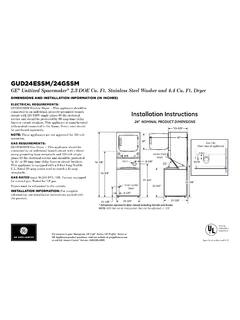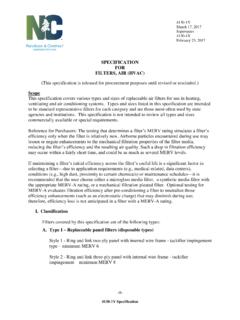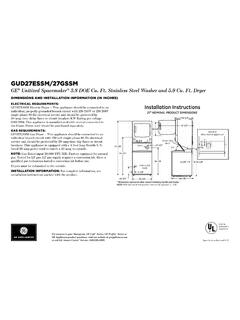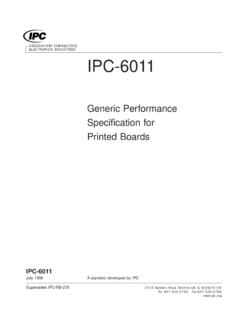Transcription of Specification for the Reinstatement of Openings in ...
1 October 2018 Specification for the Reinstatement of Openings in Highways Fourth edition May 2020 October 2018 The Department for Transport has actively considered the needs of blind and partially sighted people in accessing this document. The text will be made available in full on the Department s website. The text may be freely downloaded and translated by individuals or organisations for conversion into other accessible formats. If you have other needs in this regard, please contact the Department. Department for Transport Great Minster House 33 Horseferry Road London SW1P 4DR Telephone 0300 330 3000 Website General enquiries: Crown copyright 2020 Copyright in the typographical arrangement rests with the Crown. You may re-use this information (not including logos or third-party material) free of charge in any format or medium, under the terms of the Open Government Licence. To view this licence, visit or write to the Information Policy Team, The National Archives, Kew, London TW9 4DU, or e-mail: Where we have identified any third-party copyright information you will need to obtain permission from the copyright holders concerned.
2 3 Contents Foreword 10 Definitions 11 S0 Preamble 16 General 16 Outline of the Specification 16 Outline of the appendices 16 Outline of the Notes for Guidance 17 Using the Specification and appendices 17 S1 Operational principles 19 General 19 Guarantee period 19 Road categories 20 Footway, footpath and cycle track categories 20 Excavation and trench categories 21 Alternative options 21 Immediate works 22 Apparatus in roads, footways, footpaths and cycle tracks 22 Geosynthetic materials, geotextiles and reinforcement grids 23 Trees 23 Conciliation and arbitration 23 S2 Performance requirements 24 General 24 Surface profile 26 Fixed features 28 Surface regularity 30 Structural integrity 31 Skid resistance 33 Sampling and testing 38 Works in deteriorated or distressed areas 38 S3 Excavation 40 4 Breaking the surface 40 Excavation 40 Excavated material 41 Side support 41 Drainage 41 Shallow or aborted excavations 41 Mole ploughing and trenchless pipelaying 42 S4 Surround to apparatus 43 General 43 S5 Backfill 44 Backfill material classification 44 Alternative Reinstatement materials (ARMs)
3 45 Additional requirements 45 S6 Flexible and composite roads 47 Reinstatement methods 47 Sub-base Reinstatement 48 Base Reinstatement 48 Surface Reinstatement 50 Small Openings , narrow trenches and access chamber covers 54 Micro trenching 56 Large diameter cores 59 Base and edge preparation 63 Tolerances 69 S7 rigid and modular roads 70 Reinstatement methods 70 Sub-base Reinstatement 71 Concrete road slab Reinstatement 71 Large diameter cores 73 Edge support and preparation 73 Reinforcement 76 Overlays 78 Modular roads 78 Tolerances 79 S8 Footways, footpaths and cycle tracks 80 Reinstatement methods 80 Sub-base Reinstatement 81 5 Surface Reinstatement 82 Micro trenching 84 Large diameter cores 84 Edge requirements 84 Vehicular trafficking 86 Tolerances 86 S9 Verges and unmade ground 87 General 87 Adjacent road structures 87 Cultivated areas 88 Grassed areas 88 Verges, ditches and drainage courses 88 S10 Compaction requirements 89 Introduction 89 Compaction of materials 89 Equipment operation and restrictions 91 S11 Ancillary activities 94 Traffic signs, road markings, studs and verge markers 94 Street furniture and special features 96 Traffic sensors, etc.
4 96 Water-related matters 96 Ironwork in roads, footways, footpaths and cycle tracks 97 Test holes 100 S12 Remedial works 102 General 102 Safety requirements 102 Repair of cracking 102 Repair of settlement beyond Reinstatement limits 104 Repair of other significant defects 105 Appendix A1 Backfill materials 106 Class A Graded granular materials 106 Class B Granular materials 106 Class C Cohesive/granular materials 106 Class D Cohesive materials 106 Class E Unacceptable materials 107 Field identification tests 107 6 Appendix A2 Key to materials 111 Introduction 111 Hot rolled asphalt (HRA) mixtures 111 Stone mastic asphalt (SMA) mixtures 114 Asphalt concrete mixtures 115 Cold-lay surfacing materials 117 Flowable materials 117 Reinstatement materials for micro trenches 120 Structural layer thickness tolerances 121 Compacted lift thickness 122 Bituminous laying temperatures 124 Identification of structural layers 125 Key to materials 130 Key to Reinstatement methods 132 Summarised selection process for hot lay flexible materials 134 Appendix A3 Flexible roads 138 Flexible roads type 0 138 Flexible roads type 1 139 Flexible roads type 2 140 Flexible roads type 3 141 Flexible roads type 4 142 Sub-base construction for flexible roads 143 Appendix A4 Composite roads 144 Composite roads type 0 144 Composite roads type 1 145 Composite roads type 2 146 Composite roads types 3 and 4 147 Sub-base construction for composite roads types 0.
5 1 and 2 148 Sub-base construction for composite roads types 3 and 4 149 Appendix A5 rigid roads 150 rigid roads type 0 150 rigid roads type 1 151 rigid roads types 2, 3 and 4 152 Appendix A6 Modular roads 153 Modular roads (bituminous base) types 3 and 4 153 Modular roads (composite base) types 3 and 4 154 7 Modular roads (granular base) types 3 and 4 155 Appendix A7 Footways, footpaths and cycle tracks 156 Flexible footways, footpaths and cycle tracks 156 Composite footways, footpaths and cycle tracks 157 rigid footways, footpaths and cycle tracks 158 Modular footways, footpaths and cycle tracks 159 Appendix A8 Compaction requirements 160 Granular, cohesive and cement bound materials 160 Chalk materials 162 Bituminous mixtures 163 Appendix A9 Alternative Reinstatement materials and technologies 164 Introduction 164 General requirements for ARMs and ATs 165 Structural materials for reinstatements (SMRs) 166 Treated materials for fills (TMFs) 168 Outline scheme for approval trials 170 Appendix A10 Additional standard materials 175 General 175 Modified Type 1F Unbound Mixture (0/20) 175 Hydraulically bound materials (HBMs)
6 177 Appendix A11 Product Equivalence 185 Appendix A12 Reinstatement of modular surface layers 186 Interim Reinstatement 186 Permanent Reinstatement 186 Provision of replacement modules 189 Joint inspections and recovery of costs 189 NG1 Operational principles 192 General 192 Guarantee period 192 Road categories 193 Excavation and trench categories 195 Alternative options 196 Immediate works 198 Apparatus within the road structure 198 Geosynthetic materials, geotextiles and reinforcement grids 198 Trees 199 8 NG2 Performance requirements 201 Surface profile 201 Fixed features 202 Surface regularity 203 Structural integrity 203 Skid resistance 203 Works in deteriorated or distressed areas 204 NG3 Excavation 207 Breaking the surface 207 Excavation 207 Side support 207 NG4 Surround to apparatus 208 General 208 NG5 Backfill 209 Backfill material classification 209 Additional requirements 209 NG6 Flexible and composite roads 211 Sub-base Reinstatement 211 Base Reinstatement 211 Surface Reinstatement 212 Reinstatement of small Openings and narrow trenches 214 Micro trenches 215 Large diameter cores 217 Base and edge preparation 220 NG7 rigid and modular roads 225 Reinstatement methods 225 Concrete road slab Reinstatement 225 Edge support and preparation 226 Reinforcement 226 Modular roads 226 NG8 Footways.
7 Footpaths and cycle tracks 227 Sub-base and binder course Reinstatement 227 Surface Reinstatement 227 NG9 Verges and unmade ground 229 General 229 NG10 Compaction requirements 230 9 Introduction 230 Compaction of materials 230 Equipment operation and restrictions 232 NG11 Ancillary activities 236 Traffic signs, road markings, studs and verge markers 236 Street furniture and special features 236 Traffic sensors etc. 236 Water-related matters 236 Ironwork and apparatus 237 NGA2 Key to materials 238 Introduction 238 Hot rolled asphalt (HRA) mixtures 238 Stone mastic asphalt (SMA) mixtures 239 Asphalt concrete mixtures 241 Structural layer thickness tolerances 241 Bituminous laying temperatures 241 Selection process for hot lay flexible materials 243 NGA8 Compaction requirements 244 Bituminous mixtures 244 NGA9 Alternative Reinstatement materials and technologies 245 Introduction 245 General requirements for ARMs and ATs 246 Treated materials for fills (TMFs) 247 Outline scheme for the approval trials 247 NGA10 Additional standard materials 252 General 252 Hydraulically bound materials (HBMs)
8 252 NGA12 Reinstatement of modular surfaces 254 General 254 Examples of cement or concrete infills 254 Examples of Reinstatement of modular patterns 254 10 Foreword Our road network and the way we operate it has a direct impact on everyone s lives. Whilst the primary purpose of our highways is to facilitate safe and convenient travel for all, they also serve an important function in accommodating the essential services on which we all rely - water, gas, electricity and telecommunications. To make sure these services operate reliably, utility companies must, from time to time, maintain, repair and install apparatus under our roads. Given the impact these works can have on the travelling public, it is important that they are completed as quickly and efficiently as possible. At the same time, utilities have to reinstate the roads to certain standards to ensure they do not shorten their life or create uneven running surfaces. This statutory code of practice, published under Section 71 of the New Roads and Street Works Act 1991, is key to achieving these aims.
9 The previous edition was last updated in April 2010 and much has changed since then. Apart from issues that have arisen over its interpretation, many innovations in Reinstatement techniques and materials have been introduced that were not covered. The 4th edition is intended to address these issues and bring the document up to date. It supports innovation and allows new techniques and materials to be used. It should help reduce the time taken to carry out street works and make it easier for utilities to get their reinstatements right first time, and so avoid return site visits. It should also improve the quality and durability of reinstatements, and help to protect this vital national asset. We would especially like to thank members of the SROH working party (a Highway Authorities and Utilities Committee working group) for the considerable contribution they made in developing this edition. Their advice was invaluable in helping us to identify the issues to be addressed and in suggesting ways to resolve them.
10 We would also like to thank the wider group of experts from across this sector for their input, advice and contributions to the new SROH, and AECOM/Arup who led on the update of this document and delivered a technical Specification that will support and deliver our aims for high quality and well-managed street works. This version of the Code replaces the 3rd edition in England and comes into force as statutory guidance on 10th May 2021. It can be used by agreement with local authorities until then, especially if it helps during the coronavirus pandemic. Definitions 11 Definitions AAV Aggregate Abrasion Value - the standard measure of an aggregate s resistance to abrasion. Authority The authority as defined in the Act. Bond coat Proprietary materials certified by a Product Acceptance Scheme, generally formulated to provide cohesion between bituminous layers. CBGM base Cement bound granular mixture a mixture of controlled graded aggregate using cement that sets and hardens by hydraulic reaction.















